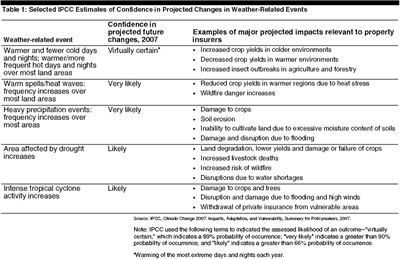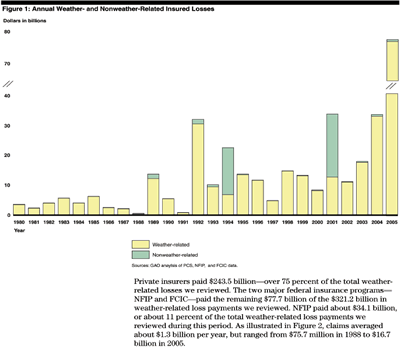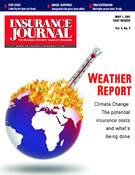Estimating the potential costs of future weather related events, linked to climate change, is, at best, an inexact science; there are just too many variables. Nonetheless, a picture is emerging that, whatever happens, the costs are likely to be huge. The Government Accountability Office (GAO) has released a report, requested by Congress, titled “Climate Change: Financial Risks to Federal and Private Insurers in Coming Decades are Potentially Significant.”
The report examines the third phase in the ongoing debate over climate change/global warming. Like the United Kingdom’s Stern Report (See IJ Web site, Oct. 26, 2006), it examines the potential economic losses, primarily from a variety of weather-related events — floods, droughts and more frequent and more powerful cyclonic storms (hurricanes and tornadoes).
The first phase focused on whether climate change, produced by global warming, was in fact happening and what those changes could reasonably be expected to produce.
The second phase continues to examine the causes behind the phenomenon, centered on the role of human activity — mainly from greenhouse gas emissions — and possible remedial actions to reduce the consequences.
The GAO points out that “catastrophic weather events” have generally increased between the period 1980 and 2005, the years the study examined. It also notes the “growth in population in hazard prone areas and increased real estate development” during the period. The two have combined to raise the exposure of the National Flood Insurance program (NFIP) fourfold “to nearly $1 trillion in 2005,” while the Federal Crop Insurance Corp. (FCIC) has seen its exposure increase by “26 fold to $44 billion.”
20 years of studies
The GAO bases its economic conclusions on a number of previously published studies that have examined what’s been happening over the last 20 years or so. It applies that data to areas of the U.S. that are potentially affected, and then calculates what the probable future effects are likely to be.
In April the Intergovernmental Panel on Climate Change (IPCC) issued a highly detailed report (www.ipcc.ch/SPM6avr07.pdf) compiled from studies conducted over the last six years. It is cited in many instances by the GAO.
Some of the more important conclusions contained in the IPCC’s study include the following:
- Changes in snow, ice and frozen ground (including permafrost);
- Increased run-off and earlier spring peak discharge in many glacier- and snow-fed rivers;
- Warming of lakes and rivers in many regions, with effects on thermal structure and water quality;
- Earlier timing of spring events, such as leaf-unfolding, bird migration and egg-laying;
- Poleward and upward shifts in ranges in plant and animal species;
- Shifts in ranges and changes in algal, plankton and fish abundance in high-latitude oceans;
- Increases in algal and zooplankton abundance in high-latitude and high-altitude lakes; and
- Range changes and earlier migrations of fish in rivers.
The GAO notes: “Much research and policy debate of late has centered on the extent to which human activities have contributed to this warming and accompanying changes in climate, and how much is due to natural variability.” But, in any case, climate change — defined by the IPCC “as any change in the climate over time due to either natural variability or as a result of human activity — may affect social and economic activities in potentially profound ways — by raising sea levels, changing precipitation patterns, and altering the frequency or severity of weather-related events.” [See chart below.]
John B. Stephenson, director of natural resources and environment, who supervised the preparation of the GAO report, summarizes its purpose as focusing on (1) what is known about how climate change might affect the frequency and severity of damaging weather-related events; (2) the extent of the insured losses incurred by private and federal insurers and reinsurers resulting from weather-related events; and (3) what major federal agencies and private insurers and reinsurers are doing to prepare for the potential risk of increased losses.
Impact on insurance
If the past serves as a guide to the future, the insurance industry may be in for some very rough going. “Major private and federal insurers are both exposed to the effects of climate change over coming decades,” the GAO concludes. However the two sectors are responding differently. “Many large private insurers are incorporating climate change into their annual risk management practices, and some are addressing it strategically by assessing its potential long-term industry-wide impacts.”
In contrast, the GAO notes, “federal insurers have not developed and disseminated comparable information on long-term financial impacts.” The GAO acknowledges that the federal insurance programs “are not profit-oriented, like private insurers” but advises nonetheless that “a strategic analysis of the potential implications of climate change for the major federal insurance programs would help the Congress manage an emerging high-risk area with significant implications for the nation’s growing long-term fiscal imbalance.”
Weather related events were the primary cause of insurance losses during the period examined [See chart on page N16]. They’ve amounted to about $321.2 billion, according to the GAO. Private insurers paid over $243.5 billion. Only 1994 (the Northridge earthquake) and 2001 (the World Trade Center attacks) saw a greater loss percentage from non-weather events.
The GAO also found that weather-related losses accounted for 88 percent of all property losses paid by insurers during this period. All other property losses, including those associated with earthquakes and terrorist events, accounted for the remainder. Weather-related losses varied significantly from year to year, ranging from just over $2 billion in 1987 to more than $75 billion in 2005.
Facing the future
The GAO report comes at a critical time, as the U.S. government has finally focused on the risks/losses posed by climate change. Both private and government insurers are directly in the line of fire. What they do will directly effect the U.S. economy and the lives of all Americans.
The GAO recognizes that “under certain circumstances, the private sector may determine that a risk is uninsurable.” The solution has been government sponsored coverage, as provided by the NFIP for flood risks and the FCIC for crop losses. These programs, however, are already strained, and greater strains lie ahead.
Citing the IPCC, the GAO said, “assessments by leading scientific bodies suggest that climate change could significantly alter the frequency or severity of weather-related events, such as drought and hurricanes.” From 1906 to 2005 the earth warmed by 1.3°F (0.74°C), and it’s expected to continue warming, probably at an even faster pace — “an additional 3.2°F to 7.2°F (1.8°C to 4° C) during the next century,” according to the IPCC.
While droughts and floods are more common, hurricanes make the headlines. In its discussion of the violent storms the GAO acknowledges the apparent increases in hurricane losses during this time period. The GAO refers to a workshop held in Germany in May 2006, sponsored by Munich Re and the University of Colorado’s Center for Science and Technology Policy Research, which brought together international experts in the fields of climatology and disaster research. They set out to determine whether increased losses were related to climate change or to socio-economic factors, “such as population density, cost of building materials, and the structure of insurance policies.” They agreed that these are the principal factors explaining weather-related losses.
However, that doesn’t end the debate, as they also “agreed that changing patterns of extreme events are drivers for recent increases in losses, and that additional increases in losses are likely, given IPCC’s projections.” The U.S. is more vulnerable than other countries. As the GAO stated: “A nation experiencing rapid growth in some of its most disaster-prone areas, may have ominous implications.”
Citing the conclusions in a study by AIR Worldwide, the GAO said that “insured losses should be expected to double roughly every 10 years because of increases in construction costs, increases in the number of structures, and changes in their characteristics.” The report estimates that “because of exposure growth, probable maximum catastrophe loss — an estimate of the largest possible loss that may occur, given the worst combination of circumstances — grew in constant 2005 dollars from $60 billion in 1995 to $110 billion in 2005, and it will likely grow to over $200 billion during the next 10 years.” The private sector would be hard pressed to cover even half of that.
These conclusions do not come as a surprise for the insurance industry, especially the reinsurers. Their very existence is directly threatened, as “a single event can cause insolvency or a precipitous drop in earnings, liquidation of assets to meet cash needs, or a downgrade in the market ratings used to evaluate the soundness of companies in the industry,” the GAO acknowledged. As a result, especially since the losses of 2004 and 2005, the industry has been recalculating its exposures, doing more scientific research and recalibrating its catastrophe models. One result has been the scarcity and high cost of coverage in disaster prone regions such as Florida and the Gulf Coast.
The GAO warned Congress that the federal programs ought to be doing the same thing, even though it recognizes that they “have access to additional federal funds during high-loss years.” The need for greater accountability is becoming critical, given the greatly increased loss exposures the NFIP and the FCIC have accumulated. However, the GAO said, “Neither program has assessed the implications of a potential increase in the frequency or severity of weather-related events on program operations,” although they have made attempts at estimating potential losses. The GAO recommends using more private sector know-how to better assess their potential exposures.
In conclusion the GAO report recommends that the Secretary of Agriculture and the Secretary of Homeland Security direct the Administrator of the Risk Management Agency and the Under Secretary of Homeland Security for Emergency Preparedness to analyze the potential long-term implications of climate change for the FCIC and the NFIP, respectively, and report their findings to Congress. This analysis should use forthcoming assessments from the Climate Change Science Program and the Intergovernmental Panel on Climate Change to establish sound estimates of expected future conditions. It said that both agencies “expressed agreement with this recommendation.”
Topics Catastrophe USA Carriers Profit Loss Flood Hurricane Climate Change
Was this article valuable?
Here are more articles you may enjoy.




 Expense Ratio Analysis: AI, Remote Work Drive Better P/C Insurer Results
Expense Ratio Analysis: AI, Remote Work Drive Better P/C Insurer Results  NYC Mayor Mamdani Widens Delivery-App Crackdown With Lost-Pay Lawsuit
NYC Mayor Mamdani Widens Delivery-App Crackdown With Lost-Pay Lawsuit  10,000 Travelers Employees Get AI Assistants Via Anthropic Partnership
10,000 Travelers Employees Get AI Assistants Via Anthropic Partnership  Warburg Mulls $1 Billion Sale of London Insurance Broker McGill
Warburg Mulls $1 Billion Sale of London Insurance Broker McGill 


